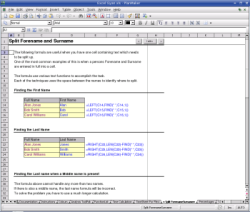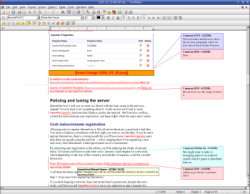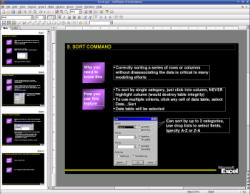Author: Mayank Sharma
The free and open source office suite OpenOffice.org might be a killer app for many, but its inability to properly display documents created in the proprietary Microsoft Office formats hinders its widespread acceptance in multi-OS business environments with many legacy .doc and .xls files. If changing over to an open document format is not an option, try SoftMaker Office. It’s no OpenOffice.org-killer, but it’s a full featured office suite that has great compatibility with Microsoft Office. Sure, it costs $80, but you can increase your karma by running it on Linux.
This isn’t SoftMaker Office’s first Linux release. We looked at a beta release of SoftMaker Office 2006, which lacked presentation software and bundled an incomplete spreadsheet program; in fact its only real usable component was the word processor. SoftMaker Office 2008 for Linux, announced last month, is the first non-beta release of the office suite for Linux, which also runs on Windows, Pocket PC, and Windows CE. It provides a word processor (TextMaker), a spreadsheet app (PlanMaker), and a presentation software (SoftMaker Presentations). You also have the ability to create databases and to draw some objects, as in OpenOffice.org, but from within the other apps rather than from standalone apps.
The first thing you notice about any SoftMaker app is its speedy launch. All SoftMaker apps launch almost instantaneously, even on relatively dated hardware. For instance, on a Celeron 1.3GHz laptop with 1GB RAM, TextMaker launches in less than a second, rather than the 8-10 seconds it takes to launch OpenOffice.org Writer.
Opening documents created with Microsoft Office is one of the greatest strengths of SoftMaker Office 2008. I tried lots of word processing documents, of various sizes and complexities, with images, tracking changes, and comments, and some based on templates. While OpenOffice.org drops in-document comments randomly, Softmaker has no difficulties reading documents, displaying them as is, and correctly attributing all changes and comments to whoever made them.
It’s a different story when it comes to importing Excel sheets, however. One of my friends who works in a Microsoft Office-dominant workplace sent me a complex 370-page Excel spreadsheet with lots of formulas and charts. PlanMaker did open the file, but said “The file could not be loaded completely. Macros and other content were skipped.” The “other content” in that file were some VBA scripts. As per PlanMaker’s documentation, it cannot yet execute macros and VBA scripts from Excel documents, and instead simply ignores them — but it doesn’t remove them, so when you save the file, the macros and scripts remain functional. By comparison, after I tuned down its security settings, OOo Calc didn’t complain about not running the macros, but even it cannot run the VBA scripts.
TextMaker can import and export documents created using OpenDocument text (.odt) format. But unlike OpenOffice.org, SoftMaker Office can neither open nor save OpenDocument spreadsheets (.ods), nor handle OpenDocument presentations (.odp). It can export documents as PDF files, and while SoftMaker’s PDF export options are not as comprehensive as OpenOffice.org’s, it has the most commonly used options, such as selecting an export range and encrypting the file.
SoftMaker Office doesn’t do too well with embedding objects. Not only can it not embed objects created using other programs, it can’t even embed files, spreadsheets, and presentations created using its own program. That means you can’t embed or link to TextMaker documents in PlanMaker spreadsheets. By contrast, OpenOffice.org has full OLE support, so you can embed all types of files and objects.
Impressive and not so impressive features
As a writer, the first thing I look for in a word processor is its spelling and grammar-related tools. In addition to a spell checker, SoftMaker Office bundles a thesaurus that is much better than the one included in OpenOffice.org. Because it allows manual input of words, it’s more usable, and it offers more appropriate meanings and synonyms.
If you work with multilingual content, SoftMaker has a feature that translates words from and to English, French, Spanish, Italian, and German. It also includes the Duden German dictionary of foreign words, which helps explain the meaning and pronunciation of words.
In a multiuser environment, many word processors users add comments and track changes to documents, and TextMaker is no exception. In fact, its comments feature is extraordinary. SoftMaker allows you to add bullets in comments and format them to use things like paragraph styles and shading. All comments are listed in a separate pane on the right, with lines connecting them to the highlighted section of the text on the left.
PlanMaker has come a long way since our last review. It can now do all the common spreadsheet tasks you can do with OpenOffice.org Calc. Despite having a similar feature set, PlanMaker executes a few features more elegantly; for instance, it handles cell validation by presenting more elegant dialog boxes. PlanMaker’s biggest shortcoming is a lack of a macro capability to automate tasks.
PlanMaker includes print settings that help you break down a long multi-sheet spreadsheet into manageable chunks by specifying print ranges, page breaks, selected cells, and worksheets, but it lacks OpenOffice.org’s ability to scale the data to fit a page.
The PlanMaker documentation doesn’t mention how many functions it supports, but it supports the most popular ones, and successfully loaded all 250 functions that were included in the Excel sheet I tested it with.
The biggest issue with the newly introduced SoftMaker Presentations component is that it can’t add charts. I didn’t notice any other commonly used features missing. In terms of compatibility with Microsoft Office, SoftMaker Presentations successfully imported a 54-slide presentation with lots of objects. It pointed out that it won’t let me edit OLE objects in the presentation, and only shows them as a preview.
SoftMaker 2008 for Linux bundles comprehensive PDF manuals for all three components, which covers both the Windows and Linux versions. Some Windows-only features, such as scanning images directly onto a document and embedding OLE objects, are clearly highlighted as not working in the Linux version.
Final word
SoftMaker Office 2008 for Linux is a capable office suite that’s pitched at Microsoft Office users. It’s better and more feature-complete than its earlier version. While it now adds a presentation component to the existing bouquet of word processor, spreadsheet program, database manager, and drawing app, the word processor remains its strongest component.
Softmaker Office 2008 for Linux offers good compatibility with the proprietary Microsoft Office formats. However, unlike OpenOffice.org, SoftMaker lacks macros, doesn’t do OLE, and only supports the Open Document Format in its word processor. Still, you may find it worth a 30-day free trial.
At $80 it’s cheaper than Microsoft Office, which with a similar set of applications, discounting Outlook for email, would cost you between $149 and $399. Add to that the cost of a Windows OS license to run Office on and you are looking at a significant cost difference between an office equipped with SoftMaker for Linux and one with Microsoft Office.
All said and done, while SoftMaker has a better-looking GUI than OOo, and has improved considerably since its last Linux release, I’m not convinced the proprietary office suite has what it takes to steal users away from OpenOffice.org.
Categories:
- Reviews
- Office Software





